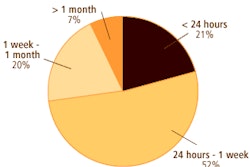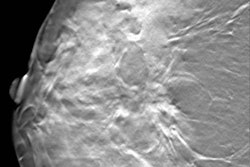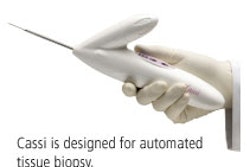The amount of breast tissue captured in a mammogram can make a crucial difference in detecting breast cancer. Yet tissue acquisition frequently is less than optimal, even at elite breast centers with highly skilled staff, and inadequate tissue acquisition undoubtedly contributes to missed cancers.
According to a recent AuntMinnie.com article, the miss rate for cancer detection on mammography, even under the best conditions, can run as high as 30%, leading to more medical malpractice suits against breast imaging specialists.
At the 2006 National Consortium of Breast Centers conference in Las Vegas, I presented research on the use of a mammography comfort aid (MammoPad, BioLucent, Aliso Viejo, CA) in combination with breast positioning training for technologists, which significantly improved tissue acquisition.
Introduction
The data was compiled based on some important premises: Tissue acquisition depends on good positioning. To get the appropriate tissue in the image, the patient's breasts must be properly positioned and the positioning must be held in place -- for each view -- until the image is taken.
But mammography-related discomfort can interfere with good positioning. Patients who find the positioning process uncomfortable tend to resist the process, and do not allow the technologist to pull sufficient breast tissue into position or apply the necessary level of compression. Even highly skilled technologists have trouble positioning uncooperative patients.
Certain patient populations are more challenging to position for various reasons, including increased sensitivity to discomfort. These populations include the following:
- Women with breast implants
- Small-breasted women
- Large-breasted women
- Women who have undergone lumpectomies and/or radiation treatment
- Women who have had recent heart surgery
- Women who have a pacemaker or a port catheter for chemotherapy
- Women who are receiving hormone replacement therapy
- Male patients
Methods
The MammoPad is a radiolucent, single-use foam cushion that covers the hard, cold surfaces of the imaging device's bucky plate. The study analyzed mammograms, performed with breast cushioning, for 211 patients from 31 facilities, ranging from small, rural breast centers to larger institutions.
The approach assumed that the broad variety of centers would also encompass a broad range of technologist skills, minimizing prior skill level as a factor.
Every technologist involved in the study underwent two hours of training on positioning with the cushion, which was approved by the American Society of Radiologic Technologists (ASRT).
Female subjects in the study received a standard four-view mammogram using the cushion. Those films were compared to the patient's most recent prior mammogram as long as the prior film was taken at the same facility. In addition, digital images were compared only to other digital images, and analog x-rays were compared only to other analog x-rays.
Click here for more information on positioning with a breast pad.
Results
Use of the cushion plus the training was associated with significantly greater tissue acquisition for all four views (p = 0.00 for all measurements). Significantly more pectoralis muscle was visualized in images using the cushion, a factor strongly associated with greater image quality.
The differences for the right and left craniocaudal views were 0.66 cm and 0.57 cm, respectively. The difference for the right oblique views was 0.65 cm and 0.56 for the left mediolateral oblique views. The difference for the right pectoralis muscle views was 1.26 cm; for the left muscle views, it was 0.86 cm.
Discussion
Clearly, the two-pronged approach of the pad plus training positively affects tissue acquisition. I believe several factors account for the effect.
The cushion has proved to substantially reduce discomfort for most women. This makes patients more cooperative, and better positioning naturally follows. The softness and texture of the cushion's foam material also produce a grip-like effect that tends to hold a properly positioned breast in place.
Positioning training also contributed substantially to the study results. The training session served as a refresher course while also introducing newer positioning techniques, such as those described in the 1999 Quality Control Manual, published by the American College of Radiology (ACR).
Finally, integrating proper positioning techniques with the cushion benefits the patient, who receives the most accurate mammogram possible.
By Tammy Coryell, R.T. (R)(M)
AuntMinnie.com contributing writer
June 27, 2006
Tammy Coryell, R.T. (R)(M), is a mammography specialist with Mammography Impact Consultants in St. Peters, MO. She is also a mammography technologist at St. John's Breast Center in Springfield, MO.
Related Reading
BioLucent debuts new MammoPad, May 16, 2006
BioLucent touts MammoPad study, March 20, 2006
Breast pad allows better images, higher patient volumes, March 1, 2005
Reports to FDA allege damage to breast implants during screening, June 15, 2004
Implants may interfere with mammograms but tumors found at similar stages, January 28, 2004
Copyright © 2006 AuntMinnie.com



















